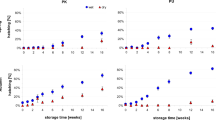Summary
The effect of drought on embryonic development and on hatching was studied in 13 European Tettigoniidae species. Drought can affect development in three different ways: (1) Embryonic development proceeds slower than if the eggs are in contact with water; (2) it stops (for final diapause) in an earlier embryonic stage; (3) it affects maintenance and termination of the initial embryonic diapause.
In many Tettigoniidae species, the initial diapause is prolonged, and may last several years. Without draught stress, between 1 and 7 cold treatments in the laboratory, and with eggs of the Tettigonia-species between 1 and 6 winters in the field were necessary to enable all eggs to complete initial diapause. In Central European species, the number of eggs maintaining initial diapause significantly increased when the eggs had no contact with water at the time when they should recover from diapause. In contrast, termination of initial diapause in Tettigonia caudata from Greece, when the environment became favorable for growth again, was highest in that group of eggs that had lost most water in a preceding period of drought. The importance of the prolonged initial diapause for the survival of unpredictable adverse conditions is discussed.
Similar content being viewed by others
References
Ando Y (1972) Egg diapause and water absorption in the false melon beetle, Atrachya menetriesi Faldermann (Coleoptera: Chrysomelidae). Appl Ent Zool 7 (1972): 142–154
Andrewartha HG (1952) Diapause in relation to the ecology of insects. Biol Rev 27:50–107
Edney EB (1977) Water balance in land arthropods. Zoophysiology and ecology 9. Springer, Berlin, Heidelberg, New York, p 282
Helfert B (1980) Die regulative Wirkung von Photoperiode und Temperatur auf den Lebenszyklus ökologisch unterschiedlicher Tettigoniiden-Arten (Orthoptera, Saltatoria) 2. Teil: Embryogenese und Dormanz der Filialgeneration. Zool Jb Syst 107:449–500
Hinton HE (1951) A new chironomid from east Africa, the larvae of which can be dehydrated without injury. Proc Zool Soc Lond 121:371–380
Ingrisch S (1983) Zum Einfluß der Feuchte auf die Schlupfrate und Entwicklungsdauer der Eier mitteleuropäischer Feldheuschrecken (Orthoptera: Acrididae). Dtsch Ent Z NF 30:1–15
Ingrisch S (1984a) Zur Verbreitung und Vergesellschaftung der Orthopteren in der Nordeifel. Decheniana (Bonn) 137:79–104
Ingrisch S (1984b) Embryonic development of Decticus verrucivorus (Orthoptera: Tettigoniidae). Entom Gen 10:1–9
Ingrisch S (1985) Effect of hibernation length on termination of diapause in European Tettigoniidae (Insecta: Orthoptera). Oecologia (Berlin) 65:376–381
Ingrisch S (1986a) The plurennial life cycles of the European Tettigoniidae (Insecta: Orthoptera). 1. The effect of temperature on embryonic development hatching. Oecologia (Berlin) 70:606–616
Ingrisch S (1986b) The plurennial life cycles of the European Tettigoniidae (Insecta: Orthoptera) 2. The effect of photoperiod on the induction of an initial diapause. Oecologia (Berlin) 70:617–623
Ingrisch S, Boekholt I (1983) Zur Wahl der Eiablageplatzes durch mitteleuropäische Saltatoria. Zool Beitr 28:33–46
Lees AD (1955) The physiology of diapause in arthropodes. Cambridge University Press
Moriarty F (1969a) Water uptake and embryonic development in eggs of Chorthippus brunneus Thunberg (Saltatoria: Acrididae). J Exp Biol 50:327–333
Moriarty F (1969b) Egg diapause and water absorption in the grasshopper Chorthippus brunneus. J Insect Physiol 15:2069–2074
Remmert H (1984) Ökologie. Springer, Berlin, Heidelberg, New York, 3. Auflage
Schmidt GH, Schach G (1978) Biotopmäßige Verteilung, Vergesellschaftung und Stridulation der Saltatorien in der Umgebung des Neusiedlersees. Zool Beitr 24:201–308
Tauber MJ, Tauber CA, Masaki S (1984) Adaptations to hazardous seasonal conditions: Dormancy, migration, and polyphenism. In: Huffaker CB, Rabb RL (eds) Ecological entomology, John Wiley & Sons, New York, Chichester, Brisbane, Toronto, Singapur, 149–183
Ushatinskaya RS (1984) A critical review of the superdiapause in insects. Ann Zool 21:3–30
Walter H, Breckle SW (1983) Ökologie der Erde Band 1 Ökologische Grundlagen in globaler Sicht. Gustav Fischer, Stuttgart, p 238
Winston PW, Bates DH (1960) Saturated solutions for the control of humidity in biological research. Ecology 41:232–237
Author information
Authors and Affiliations
Rights and permissions
About this article
Cite this article
Ingrisch, S. The plurennial life cycles of the European Tettigoniidae (Insecta: Orthoptera). Oecologia 70, 624–630 (1986). https://doi.org/10.1007/BF00379915
Received:
Issue Date:
DOI: https://doi.org/10.1007/BF00379915




